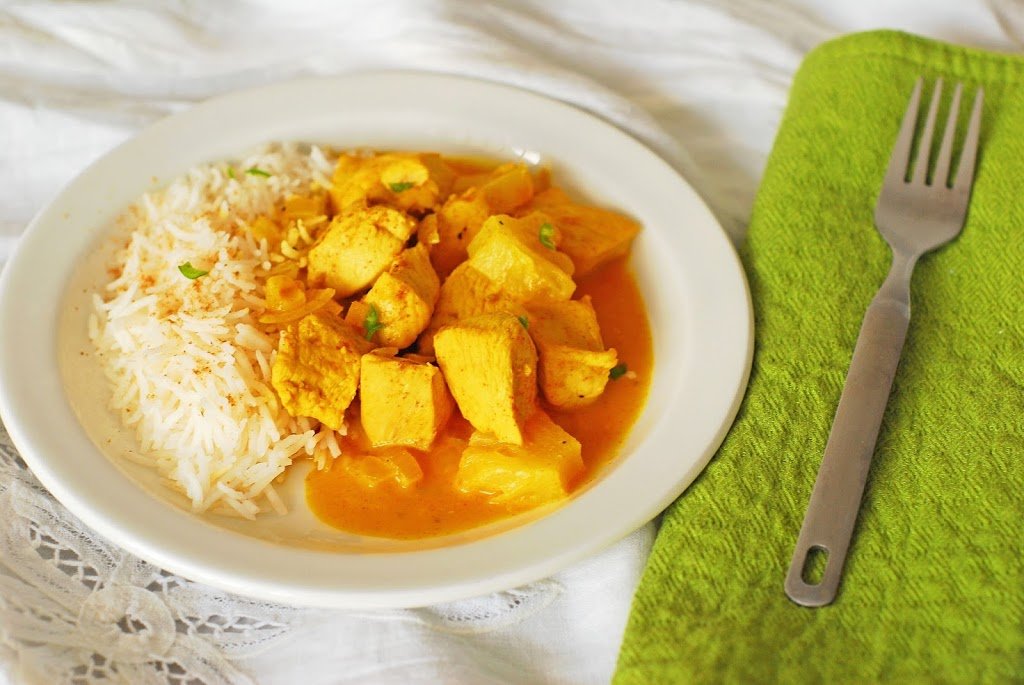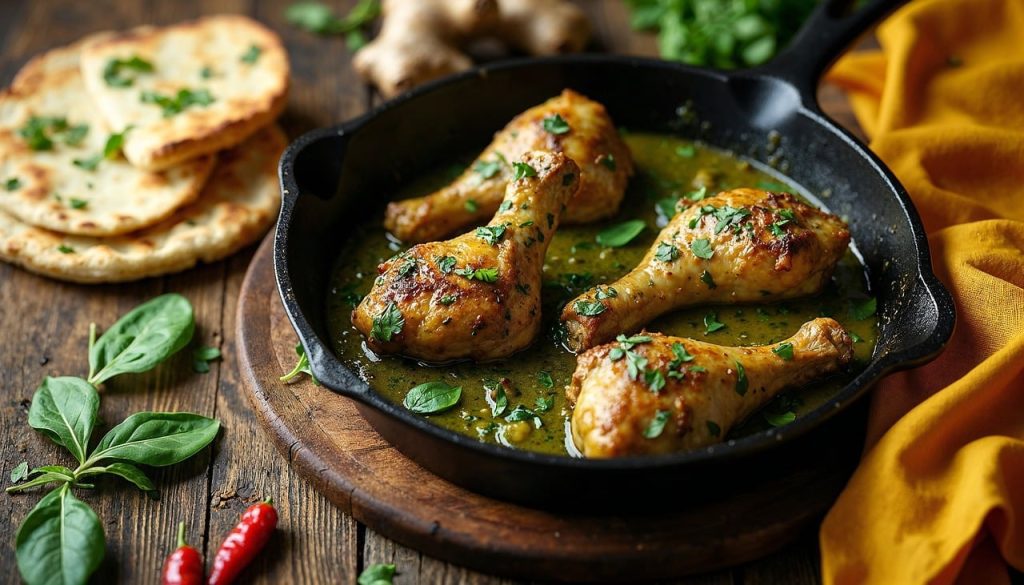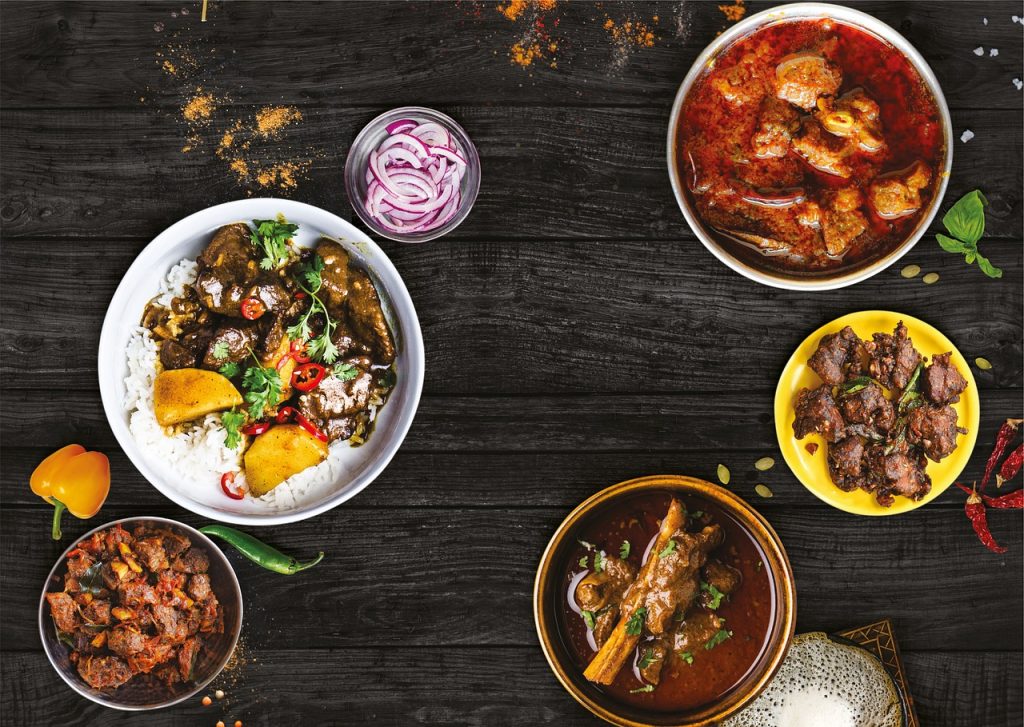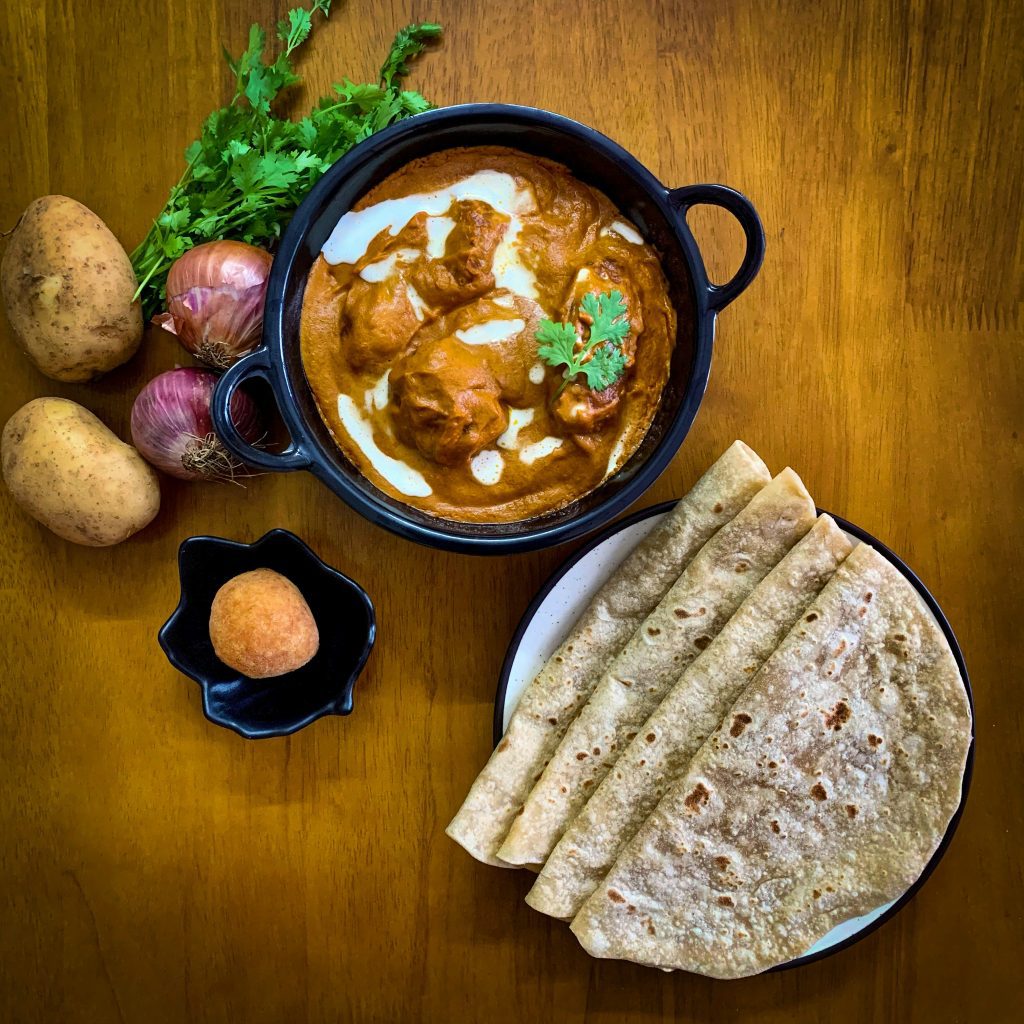Learn about How to Make Chicken and Pineapple Curry. Enjoy a flavorful chicken and pineapple curry with a perfect balance of sweet, spicy, and creamy coconut milk goodness.
Introduction
Chicken and Pineapple Curry is a beautiful dish with tender pieces of chicken cooked up with sweet, juicy pineapples served in the thick spicy coconut-based curry sauce. The given recipe blends elements of both Thai and Caribbean cuisine, accentuated here by the play between savory and sweet flavors. It is usually boneless chicken along with fresh pineapple and curry paste while crudities and frying nuts such as bell peppers and onions are common inclusions.
Coconut milk is the main ingredient that brings creamy richness to the curry while fish sauce and lime juice contribute to enhancing the taste profile. Usually presented in a Thai takeout container and served alongside steamed rice or naan, the Chicken and Pineapple Curry contains the elements of an Indian curry dish yet adds a tropical touch that is, hence, popular among patrons desiring satisfying but outlandishly flavored dishes.

Origins and Cultural Significance
Chicken and Pineapple Curry most likely shares its history with the Southeast-Asian region, and, in more specific terms, with the countries of Thailand and Malaysia, which incorporate different types of curry into their diets. The addition of pineapple to savory meals is common in these cultures since it provides a refreshing sweet note that counterbalances the heat of the curry. One can also see the patronage of those culinary illogical combinations in the Caribbean owing to the traditional ingredients of the region.
Nutritional Value of Chicken and Pineapple Curry
Chicken and pineapple curry is a complete meal; it is rich in proteins, healthy fats, vitamins, and minerals. Below are its nutrition constituents:
- Chicken: Chicken is a rich source of low-fat meat that supplies animal protein needed for muscle growth and development repair. A serving size of a standard portion contains amounts of protein that fall within the range of 25- 30 g per 100g serving and an average fat content of around (3.5 g in a skinless chicken breast), which is acceptable.
- Pineapple: Pineapple is also rich in vitamin C, with huge effects in raising immunity and enhancing digestion due to the digestive enzyme bromelain. Comparable to mango, it is also low in fat and is approximately 50 calories in every one hundred grams but has natural glucose which makes the curry sweet.
- Coconut Milk: Coconut milk is very high in calories comparable to about 200-230 calories for every 100 g serving with 20-24g of fat that has MCTs which can be an easy energy source and promote fat metabolism. Further, it is compositionally inclusive of certain trace elements such as manganese, copper, and iron.
- Spices: Other such elements and effects come from ginger, garlic, chilies, and turmeric which are all very healthy, but low in calories. For instance, turmeric has curcumin, whose activity has beneficial therapy against inflammation.
Estimated Nutritional Information (per serving):
- Calories: 400-500 (depending on portion size and use of full-fat or light coconut milk)
- Protein: 25-30g
- Carbohydrates: 20-25g (from pineapple and spices)
- Fats: 20-30g (mainly from coconut milk)
- Fiber: 2-3g
- Vitamins and Minerals: High in vitamin C (from pineapple), B vitamins, and minerals like iron and potassium.
Chicken and pineapple curry offers a good balance of macronutrients, making it a nutritious meal option when enjoyed in moderation.
How to Make Chicken and Pineapple Curry
1. Ingredients
- Chicken: The Chicken and Pineapple Curry is a dish full of colors, which has pieces of chicken tenderly accompanied by fresh sweet pineapples and served in a thick spicy coconut curry. This recipe is especially inspired by some cuisines such as Thai and Caribbean, elaborating the combination of savory and sweet food.
- Pineapple: Fresh pineapples tend to be recommended for usage in curries due to their great level of sweetness and juiciness that tends to bring a sour twist to the curry. If fresh is somehow not possible, canned pineapple is acceptable as long as it is well drained. The pineapple should be broken up into large pieces to help disperse the flavor throughout.
- Curry Paste: Red and yellow curry paste serves as a base for a wide range of dishes. It’s a combination of ground chilies, garlic, lemongrass, and a type of ginger called galanga, which imparts a lot of heat without spiciness. Change the amount to suit your spice tolerance.
- Coconut Milk: A rich and creamy texture to a hot curry dish is provided by using full cream coconut milk tamed by the spiciness of the curry. The thick coconut paste also adds some sweetness to the dish giving it a smooth finish. Thin coconut milk which is more dietary can also be used.
- Vegetables: Color, taste, and texture are portrayed well by most vegetables, most especially bell, carrots, and onions. The carrots and bell pepper’s sweetness combination goes well with the pineapples while giving the dish its savory flavors courtesy of the onion’s mild sharpness.
- Seasoning: The curry is seasoned with fish sauce, soy sauce, and lime juice. Fish sauce demonstrates its umami properties as soy sauce improves the overall depth of flavor. Lime juice cuts through the richness providing acidity which perks up the entire dish. All these ingredients help prepare a tasty and pleasing curry.
- Herbs: Usually, an addition of fresh cilantro or basil is added as this gives a hint of freshness in it. In this case, the taste is more tangy than sweet and spicy due to the taste of basil. Due to these herbs, the final presentation is colorfully and tastily done.

2. Preparation
1. Marinate the Chicken
Take chicken pieces and soak them in soy sauce, a tad of salt, and curry paste for half an hour. This is to promote the taste of the chicken and ensure that every morsel is moist and seasoned when cooked. The invasive curry advances the flavor of the chicken.
2. Cook the Aromatics
Put vegetable oil in a wide pan and heat it on at least a medium flame. Then put the diced onions and cook them until they turn translucent and sweet. Next, add crushed garlic and grated ginger and cook until their smell fills the air. This is the first step in adding a base layer of flavors to the curry.
3. Add the Curry Paste
Add the curry paste and allow it to cook for a couple of minutes. This step makes the paste aromatic. This technique helps to enhance the flavor profile of the spices. Cooking the paste is very important for the curry development.
4. Cook the Chicken
Once the chicken has been marinated, it is placed in the hot pan until its outside is slightly brown and the inside is almost done. This will lock in all the flavors from the marinade and slightly caramelize the chicken, giving it an enhanced flavor ready for the other ingredients.
5. Incorporate Pineapple and Vegetables
Then pineapples and sliced vegetables go in the pan. Mix them up and let the cooked mixture stand for a couple of minutes. The sweetness that comes from the pineapple is offset by the crunch of the vegetables making the meal appealing both in taste and visually with a combination of different elements.
6. Pour in the Coconut Milk
Add the coconut milk and incorporate it into the chicken and vegetables. Allow it to simmer for a little before cooking the curry for 15-20 minutes when the contents come to a boil. This helps to cook the chicken, disguise the sauce, and help in the incorporation of the flavors, thereby slightly increasing the thickness of the sauce.
7. Season the Curry
Savor the flavor of the curry, and if necessary correct the seasoning using fish sauce, lime juice, or extra stir curry paste. This will help you to enhance the flavors making sure that the curry has a proper distribution of sweet, sour, and salty notes.
8. Garnish and Serve
Turn off the heat when the curry is ready, and place cilantro or basil on top of the dish as a colorful and fragrant finishing touch. Accompanying the curry with steamed jasmine rice or naan bread makes it more tasteful as they provide a bland base for the rich sauced dish.
Tips for Pineapple Chicken Curry Success
- Use Fresh Pineapple: Fresh pineapple is probably the most balanced fruit in terms of sweetness and sourness hence adding flavor to the curry being prepared. There is an option to use canned pineapples where the taste and the texture may be suitable or used in a different cuisine where the storyline does not require the spices and richness of the curry.
- Don’t Overcook Chicken: Overcooking chicken in this slow-cooked curry can make it tough and dry. So avoid this by keeping a close watch on the cooking time, only cooking till it’s tender. The use of chicken thighs also helps as they remain juicier than breasts.
- Balance Sweetness and Spice: The savory sweetness of pineapple must be balanced with the spice from the curry paste. The latter should accordingly be adjusted to one’s heat tolerance to chilies and pineapple added into the dish in fractions rather than all at once then the dish would be excessively sweet.
- Simmer Gently: Allow the curry to simmer on low heat for it to blend nicely into a great smooth and tasty flavor. It helps combine the flavors without allowing the coconut milk to curdle. High heat will break the milk apart and lead to an unsavory texture.
- Season Gradually: Add fish sauce, soy sauce, or lime juice gradually while cooking. Since you add ingredients one at a time, you can get your dish to taste exactly like it should: salty, tart, and sweet, balanced so that no part overpowers the others.
Why You Should Try Chicken and Pineapple Curry
Chicken and pineapple curry is quite a delight if you like the blending of sweet and savory elements. It is adventurous yet comfort food for those who love rich, layered flavors. Whether it’s cooked in your kitchen or ordered at one’s favorite eatery, you can be rest assured to experience a truly unforgettable dining moment from this complex confluence of spices, sweetness, and creaminess.

Popularity and Cultural Significance
This particular dish is a regional favorite in places like Thailand, Malaysia, the Caribbean,n and the like, where tropical fruits and spices are prevalent. Sweetness combined with heat is a characteristic of these regions” culinary traits of balancing all the flavors. In addition, it is enjoyed by many around the globe in restaurants focusing on fusions of different cuisines, where old ingredients are altered by modern chefs in new ways.
FAQs
What type of chicken should I use?
Similarly, for Chicken and Pineapple Curry, chicken boneless skinless thighs or breasts can be used. Chicken thighs have the advantage of being tender and juicy, while if you want a leaner option chicken breasts can work too. Just cut the chicken into uniform bite-size pieces.
Can I use different proteins for this curry?
Shrimp, tofu, and beef can take the place of chicken as well. They will need their measure of cooking time, but the curry taste will go that well with whatever protein you decide to use.
Can I make this curry spicier?
Yes, you can reduce or increase the spiciness by using more curry paste / fresh chilies in the dish. Red curry paste is hotter than yellow curry paste so buy that which is humanely tolerable to your heat levels. Always remember to taste while you cook.
Can I use canned pineapple instead of fresh?
Yes, you can substitute fresh pineapple with canned ones. However, the flavor and texture of cooked fresh pineapple are far better than that of canned ones. If coping canned pineapple, make sure to drain it properly so that there will not be too much liquid that will water down the flavors of the curry.
Conclusion
Chicken and Pineapple Curry is this great taste sensation vibrant, scrumptious, and magically savory and sweet all in one. Its versatility, flexibility, and ease of preparation make it suitable for both weeknight dinners and special nights out. Try it in your kitchen, or try it at a restaurant nearby- not only will you find an experience for your palate, but also a kind of flavor.
